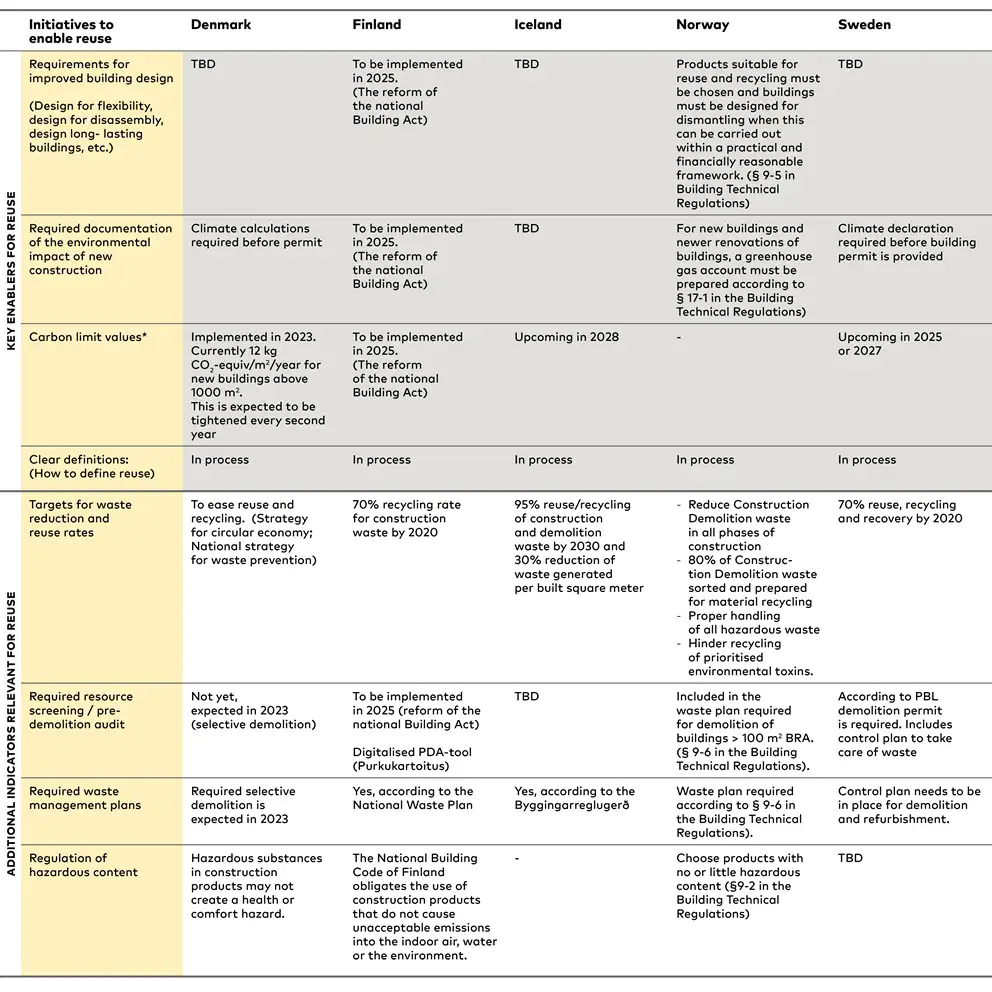Sum of Complexity – What Hinders Reuse?
Nordic Sustainable Construction has - in collaboration with the consulting company Norion Consult- published a report that provides an overview of European and Nordic policy initiatives with significant positive or negative impact on the possibility of reusing construction products.
The report furthermore highlights opportunities to support the reuse of construction products in the Nordics further.
Overall, the findings indicate that reuse is hindered by the sum of complexity resulting from not only the policy framework, which has been developed based on sometimes conflicting priorities, but also from cultural, market-based and technical barriers.
Nevertheless, there is a window of opportunity where the legislative foundation for reusing construction products is being improved. The Nordic countries may take further advantage of this window of opportunity through cooperative Nordic efforts. One low-hanging fruit is to get inspiration from each other as well as to harmonise upcoming Nordic policies, methodologies and definitions related to reuse of construction products.
The European Policy Landscape for Reuse
According to the European waste hierarchy, reducing waste is still the superior strategy to reduce our environmental footprint. However, reuse of construction products can preserve cultural and immaterial values, embodied emissions and virgin resources far more effectively than the established recycling and recovery strategies. Furthermore, reuse of construction products is assumed to have less negative impact on biodiversity due to a reduced demand for new resources.
At the moment, there are no requirements for reuse, but the revision of the Construction Products Regulation (CPR) will be an important factor in enabling reuse on a political level. While the CPR does not currently support reused construction products, the report provides a Nordic perspective on how it may further support reuse in its revised version, and analyses CPR in detail
The Nordic Policy Landscape for Reuse
Overall, the effort to minimise raw material extraction and usage is increasing. But a tendency is that Nordic legislation seeks to increase reuse through indirect measures rather than requiring the reuse of construction products. Generally speaking, most Nordic countries will be looking into revising and updating current raw material plans and circular economic strategies with new and more ambitious circularity targets for construction.
One factor that has been identified as a potential barrier to reuse of construction materials in the Nordic countries is technical specifications and regulations in the Nordic building codes. Despite the importance of safety regulation in the construction industry, building regulations are by some stakeholders viewed as a significant obstacle to reuse of construction products.
On the other hand, several policy initiatives across the Nordics are initiated to enable the reuse of construction products as can be seen in the table below.

Table: The indicators listed in the table above have been pointed out as relevant in terms of enabling the reuse of construction products.
Potential for Nordic Harmonisation and Inspiration of Enabling Policies for Reuse
Some of the listed indicators in the table above have been identified as particularly relevant regarding a future harmonisation of enabling policies in the Nordic countries and beyond.
Among these indicators are ‘Requirements for improved Building Design’ – including more flexible and adaptable designs (such as design for disassembly) and ensuring longer-lasting buildings by being aware of the choice of materials and the lifespan and quantities of these and ‘Climate Impact of construction’ where some Nordic countries are already implementing direct regulations in their national legislation.
Furthermore, a step towards harmonised regulation in the Nordics might be a common definition of reuse or a clear overview of the different definitions and their differences.
Another essential enabler to using reused materials in the Nordics is Life Cycle Assessment (LCA). The central question is, how we calculate the emissions from reused construction products in LCA for construction. As you can read in the report and also in our article Reuse of construction materials is rewarded in the Nordic building LCA | Nordic Sustainable Construction, initial steps towards harmonised LCA-scopes have been taken, but there is still an open window towards harmonisation of several modules of the Nordic LCA regulations.
In the report you will furthermore find country snapshots from the Nordic region showcasing national policies which influence the reuse of construction products and references for additional reading.